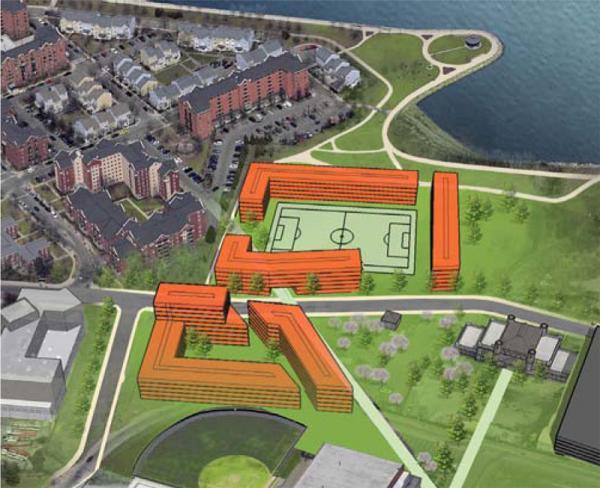January 22, 2015

A rendering from a 2009 Master Plan document shows where two potential student dorm complexes could be built on the UMass Boston campus. Image courtesy UMass Boston
The University of Massachusetts is moving forward with plans to build its first-ever student dormitory on the Dorchester campus of UMass Boston. A request for proposals will be issued this spring seeking proposals from private developers who would lease land from the university to build a 1,000 bed residential facility with a dining hall.
“We’re doing a preliminary review of whether we can do public-private partnerships to build the 1,000 bed residence hall at UMass Boston that would serve freshman or first year students,” said Patricia Fillipone, the executive director of the UMass Building Authority. “We’re looking to partner with a developer to build that residence hall.”
On Dec. 8, the UMass Building Authority issued a Request for Qualifications (RFQ), a document that serves to gaugue the interest of developers in the plan. According to Fillipone, there were eight respondents to the RFQ. The Building Authority is currently reviewing those responses, she said, and will then formulate a Request for Proposals (RFP) to solicit more formal bids from the development community.
“We would expect that it would happen sometime in the spring of 2015,” said Fillipone.
The budget for the new facility— which could be sited on one of two preferred locations on the UMass Boston campus— is estimated at $113 million.
“We envision that we would lease the land to the developer and they would build and operate the building,” said Fillipone, who said this “public-private” model for building a dorm is a “first of its kind” on any UMass campus.
In 2009, UMass Boston published a 25 year Master Plan that outlined its intent to build-out the Dorchester campus, including new academic buildings and the first-ever on-campus student housing. Although hundreds of UMass students presently live close to campus in privately-owned residential properties on the Columbia Point peninsula— like Peninsula Apartments and Harbor Point— there have never been any on-campus dorms built.
The Master Plan document pin-pointed two locations on UMass controlled land where a dorm facility could be built. The first is located adjacent to the Peninsula Apartment complex. A second is situated near the existing Calf Pasture Pump Station, a building that UMass Boston now owns that is listed on the National Register of Historic Places.
The subject of on-campus housing has been fraught with controversy before. In 2003, the UMass administration tried to advance a plan to build 2,500 housing units on the campus. That effort encountered fierce resistance from civic and political leaders, including Mayor Thomas Menino, who wrote a letter asking that the plan be abandoned. Many opponents argued at the time that the creation of dorms conflicted with the university’s mission of serving students from the Greater Boston region; others worried that dorms would upset the local housing market or lead to a proliferation of student off-campus housing and attendant quality of life problems.
But, the tone of the conversation has changed in the intervening years. The university’s Master Plan — with its explicit plan to create 2,000 beds on campus initially “to fulfill student demand”— has not generated such widespread push-back to date. UMass Boston has also acquired new land in that time, most notably the 30 acre, waterfront Bayside Expo Center property— which is now being eyed by Olympic planners as a possible site for an Athletes Village if Boston is chosen to host the 2024 Summer Games. Conceptually, those residential units for athletes would be used as student housing either before or after the games, a concept supported by current UMass Boston Chancellor Keith Motley, who has been a chief proponent of the Olympics bid.
But this specific dorm plan currently being vetted by the UMass Building Authority is unrelated to the Bayside site.
The two sites identified in the Master Plan are closer to the core campus. The first— labeled R1 in the Master Plan— is located next to the existing Clark Athletic Center and is described in the document as the “preferred location for Phase One of a proposed student residential precinct.” The second— R2— is identified as “the preferred location for Phase Two” in the northwestermost corner of the campus adjacent to the Harbor Point development.
Villages:
Topics:


